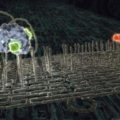
University of Michigan researchers say that a new technique for vaccinating against a variety of infectious diseases – using an oil-based emulsion placed in the nose, rather than needles – has produced a strong immune response against smallpox and HIV in two sets of experiments.
The so-called nanoemulsion vaccines are based on a mixture of soybean oil, alcohol, water and detergents emulsified into ultra-small particles smaller than 400 nanometers wide (about 1/200th the width of a human hair). These are combined with all or part of the disease-causing microbe to trigger the body’s immune system.
The smallpox results, which appear in the journal Clinical Vaccine Immunology, could lead to an effective human vaccine against smallpox that is safer than the present live-vaccinia virus vaccine because it would use nanoemulsion-killed vaccinia virus. In experiments, the killed-vaccinia virus nanoemulsion vaccine was placed in the noses of mice to trigger an immune response. The researchers found the vaccine produced both mucosal and antibody immunity, as well as Th1 cellular immunity, an important measure of protective immunity.
When the mice were exposed to live vaccinia virus to test the vaccine’s protective effect, all of them survived, while none of the unvaccinated control mice did. The researchers conclude that the nanoemulsion vaccinia vaccine offers protection equal to that of the existing vaccine, without the risk of using a live virus or the need for an inflammatory adjuvant such as alum hydroxide. “We found that the nanoemulsion vaccine could inactivate and kill the virus and then subsequently induce immunity to the virus that includes cellular immunity, antibody immunity and mucosal immunity,” Baker explained.
Baker’s team has also published results from a preliminary test of a nanoemulsion vaccine’s effectiveness against HIV in the journal AIDS Research Human Retroviruses. In the study, the nanoemulsion HIV vaccine showed it was able to induce mucosal immunity, cellular immunity and neutralizing antibody to various isolates of HIV virus. A protein used by the team, gp120, is one of the major binding proteins under study in other HIV vaccine approaches.
“This was an exploratory study to see if further research is warranted,” Baker said. His team plans further research to test the concept in animal models, potentially with whole viral vaccines or ones with multiple protein components.
Related:
Viral-Vector Vaccines Vexed
Nanoparticles Transport Gene Therapy


















Comments are closed.